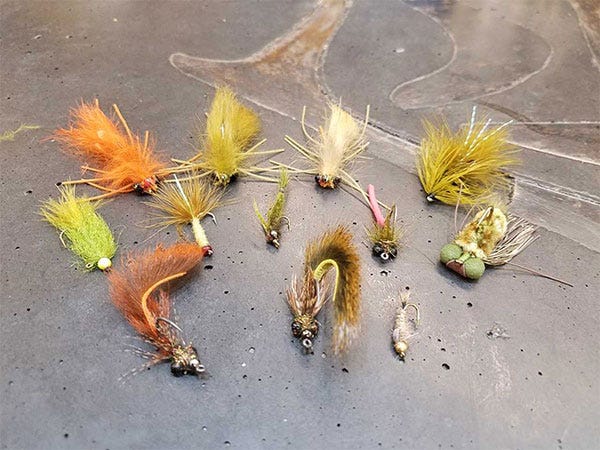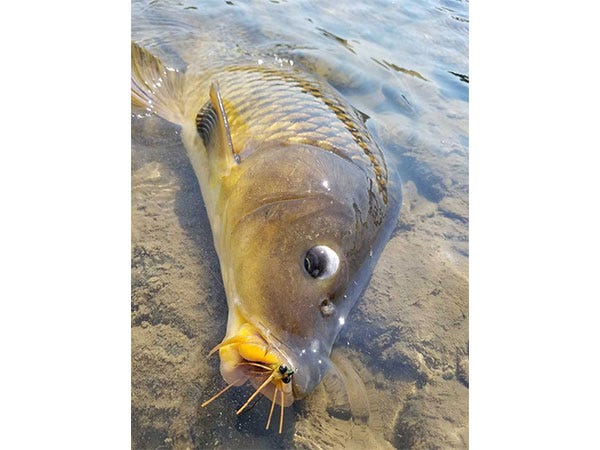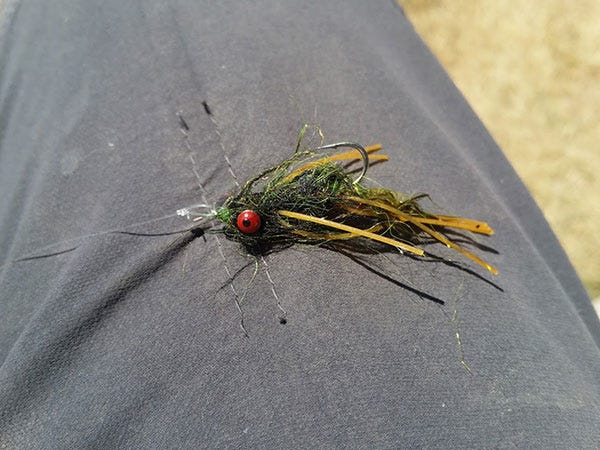Which Flies Catch Carp?


As a fly shop, trout still butter our bread, but more and more, people are asking about carp and want to know what flies to use. Before I provide my list, I’m going to delve briefly into carp behavior and some important fly designs characteristics.
Carp are opportunistic feeders. They often don’t wait for food to present itself. Instead, they root it right out from where it is hiding. Apparently, it’s an efficient way to feed and probably why they get so darn large.
Flies can be imitative of nymphs, worms, leeches, crayfish and sculpin or minnows. In some situations, carp will even eat seeds and vegetation. At times, you can also find them working a hatch and eating dries like mayflies, caddis or terrestrials. Depending on where you live and what you observe, there are many food sources to imitate. For my carp fishing, I find that nymphs, crayfish and leeches will regularly get the job done.
Learn more about fly fishing for carp, also known as River Gold.
The key to designing carp flies it to imitate food sources in a package that will be discovered by the fish without spooking them in the process. Profile, movement and sink rates are the key characteristics.
I should also mention that all my carp fishing is sight fishing. I don’t blind cast. It’s not that you can’t catch carp by blind casting, it’s that you can find so many fish feeding in shallow water. I prefer to sight and stalk them. In the standard scenario, I like to see my fly and guide it to the mouth of a feeding fish. If I can’t see the fly, I still prefer to cast at fish I can see. For me, that’s what makes carp fishing so much fun.

Profile
In dirty water, slightly larger flies are often desired for the angler to track and the carp to find. In clear water, it usually takes a slimmer or smaller pattern to fool them. Carp are wary by nature, so if the pattern is out of place, they will ignore it or even spook the moment they see it.
Since carp are often feeding on the bottom, a pattern that tips upward, so the rear portion of the fly remains in view is often very important. Sometimes, you will need to let your fly sit until the fish has approached it. Other times, you will want to crawl your pattern along the bottom in front of a feeding fish. In any event, you’ll want the hook pointing up toward the carp’s mouth and not down to the bottom.
Movement
Carp seem to like flies with soft wiggly parts. You’ll want to use patterns that utilize rubber or silicone legs, marabou and soft fur, like rabbit or pine squirrel. Movement of the fly as it drifts, while it is crept along the bottom or simply rests, is the key to selling it.
Want to know what it's like to catch carp in Tokyo?
Sink Rate
Carp won’t eat your fly if they don’t see it, so sink rate is a major key based on the situation. I often tie the same pattern in three versions; unweighted for skinny water, bead chain eyes for general use and brass or lead dumbbell options for moderate to heavy current. In most situations, you will be leading the fish by several feet or more.
Ultimately, your fly needs to achieve the proper depth and arrive right near the carp’s mouth, so they discover it right in their feeding zone. Sink rate is often the single most important presentation factor. If you throw to a fish in shallow water with a heavy fly, the splashdown will likely lead to an explosion of silt and a lost opportunity. Conversely, if a fish is mudding or bottom feeding in significant current, you will need a fly that plunges to the bottom quickly, to put it right in his face.

My Primary Carp Fly Selection
Olive Balanced Leech with Chartreuse Bead Head
Ideal when a slim pattern is desired. The chartreuse head makes it easy for me to track in order to guide it into position in front of a fish. The Olive/Chartreuse Balanced Leech has been my number one fly for the past four seasons when I’m working for feeding, mudding fish in semi-clear water.
Carpin Crunch
Perfect when a little bulk is desired. I imagine this pattern is a suitable representative of a baby crayfish or possibly even a sculpin. In any event, the carp seem to crunch it more often than not. The Carpin Crunch is tied Clouser style so the hook rides up. The rubber legs also act as outriggers, keeping the hook upright. It helps the hook stay off the bottom and make it ready to do its business when it gets vacuumed up by Mr. Rubber Lips.
Jigged Zirdle (bead chain eyes)
Crayfish are basically like shrimp and all creatures love to eat shrimp. Carp are ideally suited to crunch right through their shells. The JZ seems to have just the right balance of sink rate and movement to imitate a crayfish. Olive is generally best in clearer water and Crawfish Orange works great in the dirty stuff.
Why learn to tie your own flies?
Hares Ear
In very clear water, sometimes a small nymph is the only thing you can deliver to a carp and not spook it. While you won’t likely be able to spot your fly, you should be able to see the fish and get your nymph to where the carp can discover it. It may not be easy.
Damsel
When fish are cruising, the light slim damselfly is an ideal choice. It’s also good for spooky fish in clearer water lakes during the summertime. There are also a lot of damsel nymph choices. If you have a favorite for trout, try it on carp. Halsam’s ultra damsel featuring micro rubber legs is a great choice.
Dragonfly Nymph
When carp get picky and snub my usual flies, I get techy and drop shot a floating dragonfly nymph or boobie style fly. Utilizing a floating line, long leader, and a split shot, I can place the shot 4-12” above the fly and drop it down, hovering it at the level it needs to be. The great thing about this presentation is that you can lead fish by a long way, waiting for them to move into view. If the fly is hovering and waiting, a twitch or two and it’s game on.
Wooly Bugger
I always carry a few unweighted buggers. Sometimes the good old wooly is the perfect prescription for cruisers or laid up sunning fish. My personal best carp took a #10 olive bugger.
Other Choices
Headstand
This is a popular pattern we carry in our bins at North 40. I’ve had good results with an olive headstand for spooky clear water river carp.
Hybrid
This is another popular pattern we carry. I’ve had my best results with this one in dirty water. In clear water, I’ve had carp run from it. Maybe they’ve seen it before? Your results may vary. I’ve talked to some carp anglers who swear it’s the best fly.
Do you want to come up with your own carp catching fly? See our selection of fly tying materials.
Have you Tried Them?
Sight fishing for carp is really fun. Carp are large, strong and readily available. When the weather gets hot, the water turns warm and trout fishing during the day gets tough, carp fishing is in its prime. I used to think the reason to fly fish for carp was to hone one’s skills for saltwater flats fishing. Now, I fly fish for carp because it can be even more fun than saltwater flats fishing. Not only do I get lots of shots at large fish, but I can even do it in my own neighborhood or within a short drive from town.
